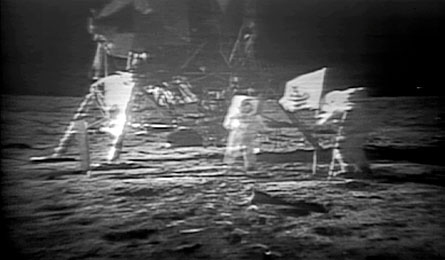To view video footage of the newly restored moon walk, click here.

WASHINGTON — At a press conference July 16, the 40th anniversary of Apollo 11’s launch, NASA previewed digitally restored snippets of the first video beamed from the moon’s surface to Earth. These vignettes, including astronaut Neil Armstrong’s first steps onto lunar soil, are part of a three-month, $230,000 project to assemble video footage of the moon walk from a variety of sources into “a historical record for future generations,” said Richard Nafzger, an engineer at NASA’s Goddard Space Flight Center in Greenbelt, Md., and leader of the effort.
Sources of video for the new project include CBS, a television station in Australia and the National Archives, where some of the video footage has ended up, Nafzger says. He and his colleagues must cobble together video from these recordings because NASA evidently erased its own high-quality tapes. Per NASA procedures at the time, the 45 tapes that contained video of the 3 ½–hour moon walk were kept for just a few years before Apollo program personnel certified that the data wasn’t needed anymore, and the tapes were reused.
The brief snippets released today are “just a sneak peek at three weeks’ worth of work,” said Mike Inchalik of Lowry Digital in Burbank, Calif., the film restoration firm where the full record of the Apollo 11 moon walk is being reassembled. “Nothing is being added to the video,” says Inchalik, who emphasized that his company specializes in film restoration, not special effects. “We’re just extracting the information that’s there already.”
The restored images, which are taken from the best of the broadcast-format videos, reveal details not easily seen originally on televisions worldwide. Such details include reflections in the faceplates on the astronauts’ helmets and better contrast in deeply shadowed areas.
Although none of the original NASA tapes apparently survived the ’70s, Nafzger recently got wind that similar tapes — recorded in Australia by scientists from John Hopkins University’s Applied Physics Laboratory — made their way back to the United States after the mission. The search for those recordings, which might have suffered the same fate as NASA’s tapes, continues, he notes.
NASA expects to release a digitally restored version of the entire Apollo 11 moon walk in September. In the meantime, the newly restored excerpts of the moon walk can be downloaded or viewed at the NASA website.
On July 16, the 40th anniversary of NASA’s launch of Apollo 11, the space agency released newly restored footage of some iconic moments from that mission’s moon walk. Here, astronauts Neil Armstrong and Buzz Aldrin plant the U.S. flag in lunar soil.
Credit: NASA






